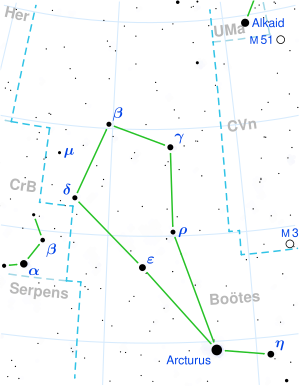 The brown dwarf 2MASS 1503+2525 is marked with a white arrow. The image also shows the star EX Boötis and a galaxy group. Credit: legacy surveys | |
| Observation data Epoch J2000[1] Equinox J2000[1] | |
|---|---|
| Constellation | Boötes |
| Right ascension | 15h 03m 19.613s[1] |
| Declination | 25° 25′ 19.68″[1] |
| Characteristics | |
| Spectral type | T5[2] |
| Astrometry | |
| Radial velocity (Rv) | 33±14[3] km/s |
| Proper motion (μ) | RA: 87.414±0.613[4] mas/yr Dec.: 557.780±0.695[4] mas/yr |
| Parallax (π) | 155.7758 ± 0.7557 mas[4] |
| Distance | 20.9 ± 0.1 ly (6.42 ± 0.03 pc) |
| Other designations | |
| Database references | |
| SIMBAD | data |
Location of 2MASS 1503+2525 in the constellation Boötes | |
2MASS J15031961+2525196 (2MASS 1503+2525) is a nearby brown dwarf of spectral type T5.5,[5] located in the constellation of Boötes at approximately 20.7 light-years from Earth.[6]
History of observations
Discovery
2MASS 1503+2525 was discovered in 2003 by Adam J. Burgasser et al. in wide-field search for T dwarfs using the Two Micron All Sky Survey (2MASS).
Distance
Originally the most precise distance estimate of 2MASS 1503+2525 is a trigonometric parallax, published by Dupuy and Liu in 2012: 157.2 ± 2.2 mas, corresponding to a distance 6.36 ± 0.09 pc, or 20.7 ± 0.3 ly.[6] The parallax was further refined by Gaia mission in 2018 to 154.9208±1.1025mas. The brown dwarf 2MASS 1503+2525 lies in local void 6.5 parsecs across, where relatively few stars and brown dwarfs are located.[7]
Physical properties
The 2MASS J15031961+2525196 is the spectral standard of the spectral class T5.[8]
References
- ^ a b c d e "2MASS J15031961+2525196 -- Brown Dwarf (M<0.08solMass)". SIMBAD. Centre de données astronomiques de Strasbourg. Retrieved 2013-09-19.
- ^ Martin, Emily C.; Mace, Gregory N.; McLean, Ian S.; Logsdon, Sarah E.; Rice, Emily L.; Kirkpatrick, J. Davy; Burgasser, Adam J.; McGovern, Mark R.; Prato, Lisa (2017), "Surface Gravities for 228 M, L, and T Dwarfs in the NIRSPEC Brown Dwarf Spectroscopic Survey", The Astrophysical Journal, 838 (1): 73, arXiv:1703.03811, Bibcode:2017ApJ...838...73M, doi:10.3847/1538-4357/aa6338, S2CID 28337547
- ^ Robert, Jasmin; Gagné, Jonathan; Artigau, Étienne; Lafrenière, David; Nadeau, Daniel; Doyon, René; Malo, Lison; Albert, Loïc; Simard, Corinne; Gagliuffi, Daniella C. Bardalez; Burgasser, Adam J. (2016), "A Brown Dwarf Census from the Simp Survey", The Astrophysical Journal, 830 (2): 144, arXiv:1607.06117, Bibcode:2016ApJ...830..144R, doi:10.3847/0004-637X/830/2/144, S2CID 119192461
- ^ a b c Brown, A. G. A.; et al. (Gaia collaboration) (2021). "Gaia Early Data Release 3: Summary of the contents and survey properties". Astronomy & Astrophysics. 649: A1. arXiv:2012.01533. Bibcode:2021A&A...649A...1G. doi:10.1051/0004-6361/202039657. S2CID 227254300. (Erratum: doi:10.1051/0004-6361/202039657e). Gaia EDR3 record for this source at VizieR.
- ^ Burgasser, Adam J.; Kirkpatrick, J. Davy; McElwain, Michael W.; Cutri, Roc M.; Burgasser, Albert J.; Skrutskie, Michael F. (2003). "The 2Mass Wide-Field T Dwarf Search. I. Discovery of a Bright T Dwarf within 10 Parsecs of the Sun". The Astronomical Journal. 125 (2): 850–857. arXiv:astro-ph/0211117. Bibcode:2003AJ....125..850B. doi:10.1086/345975. S2CID 15764829.
- ^ a b Dupuy, Trent J.; Liu, Michael C. (2012). "The Hawaii Infrared Parallax Program. I. Ultracool Binaries and the L/T Transition". The Astrophysical Journal Supplement. 201 (2): 19. arXiv:1201.2465. Bibcode:2012ApJS..201...19D. doi:10.1088/0067-0049/201/2/19. S2CID 119256363.
- ^ Bihain, G.; Scholz, R.-D. (2016), "A non-uniform distribution of the nearest brown dwarfs", Astronomy & Astrophysics, 589: A26, arXiv:1603.00714, Bibcode:2016A&A...589A..26B, doi:10.1051/0004-6361/201528007, S2CID 119102741
- ^ Tinney, C. G.; Kirkpatrick, J. Davy; Faherty, Jacqueline K.; Mace, Gregory N.; Cushing, Mike; Gelino, Christopher R.; Burgasser, Adam J.; Sheppard, Scott S.; Wright, Edward L. (2018), "New y and T Dwarfs from WISE Identified by Methane Imaging", The Astrophysical Journal Supplement Series, 236 (2): 28, arXiv:1804.00362, Bibcode:2018ApJS..236...28T, doi:10.3847/1538-4365/aabad3, S2CID 54970570

